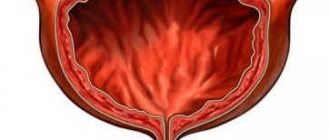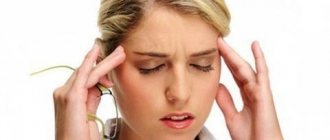Maltseva Marina Arnoldovna
Head of the consultation department - neurologist, specialist in the field of extrapyramidal pathologies, doctor of the highest category
Shabunina Ekaterina Mikhailovna
Neurologist, category 2
Vegetative-vascular dystonia is a syndrome in which a child has reduced vital activity of the vessels of the circulatory system. This is caused by pathologies in the functioning of various organs and organ systems. Modern medicine considers vegetative-vascular dystonia as a borderline state between a disease and a healthy state.
Signs of vegetative-vascular dystonia
Due to the variety of types of dystonia, its clinical symptoms are quite diverse. The difficulty of making an appropriate diagnosis also lies in the fact that, for example, in children it is somewhat more common than in adults. This may cause the doctor to make an erroneous diagnosis.
At different ages, the symptoms of vegetative-vascular dystonia are as follows:
- change in the condition of the skin. They consist of the appearance of rashes, itching;
- weight loss or, conversely, excessive weight;
- rise or fall in temperature for no apparent reason;
- loss of interest in favorite activities;
- breathing problems;
- headache. Often the headache with vegetative-vascular dystonia is very severe, which forces parents to resort to the use of painkillers.
Headaches usually get worse in teenagers. This is facilitated by hormonal changes in the body. Children become more irritable and lose interest in learning.
Symptoms of autonomic dysfunction (almost all occurring sharply and acutely):
- changes in heart rhythm (tachycardia or bradycardia);
- feeling of lack of air, shortness of breath;
- pallor of the skin or, on the contrary, redness as a result of a rush of blood;
- increase or decrease in blood pressure;
- heartache;
- feeling of fear, anxiety;
- headache;
- dizziness, weakness, near fainting, tingling and goose bumps, noise in the head;
- chills;
- sweating;
- sore throat.
One of the most common options is a panic attack. This is a sudden onset anxiety disorder, initiated by a sharp release of the stress hormone - adrenaline. The pulse and breathing quicken, despite this the person feels short of air, experiences increasing anxiety, dizziness, weakness in the legs. Symptoms appear in attacks, with the attack passing in 10-40 minutes, leaving behind a feeling of weakness and a feeling of fear of a new attack. Over time, the situation only gets worse - the person becomes a slave to his fear of a new attack. A particular danger of VSD is an increased tendency to commit suicide. However, it is possible to help people suffering from autonomic dysfunction. The initial stages of VSD are treated with several visits to a psychotherapist. More advanced cases require complex treatment from a neurologist, but they are also not hopeless. Breaking the vicious circle of fear and pain is the main goal of treatment.
Features of the fight against headaches
To ensure that headaches as a symptom of vegetative-vascular dystonia appear as little as possible, it is advisable to follow these recommendations.
- Adhering to recommendations for a rational daily routine.
- Regular exercise, but only with acceptable loads.
- The diet should be balanced with a limit on salty, smoked and sweet foods.
- Massotherapy.
- Taking multivitamins.
- Phytotherapy.
And only when these recommendations do not bring the desired effect, doctors resort to drug treatment. For children and adults, the most effective drugs are selected at the lowest possible dosage.
Clinical Brain Institute Rating: 3/5 — 4 votes
Share article on social networks
Treatment of headaches with VSD
Treatment measures for this pathological process should begin after an accurate diagnosis has been established and other diseases have been excluded. After diagnosis and the absence of any pathologies that can provoke headaches, a patient with characteristic complaints should contact a neurologist or psychiatrist. Treatment of headaches associated with VSD involves eliminating the influence of pathological impulses that cause pain.
For these purposes the following should be prescribed:
- nootropic drugs (Nootropil, Piracetam), which will normalize metabolic processes in brain cells;
- tranquilizers (Sibazon, Phenazepam). This group will eliminate unnecessary fears and suspiciousness in patients;
- antidepressants – in the presence of developed depression.
An effective way to treat headaches with dystonia is psychotherapy, which allows patients to eliminate suspiciousness, fears and anxiety on a conscious level. Treatment of headaches with vascular dystonia must be supplemented with acupuncture, laser treatment of active points, and special types of massage.
The text was checked by expert doctors:
Head of the socio-psychological service of the Alkoklinik MC, psychologist Yu.P. Baranova, L.A. Serova, a psychiatrist-narcologist.
CAN'T FIND THE ANSWER?
Consult a specialist
Or call: +7 (495) 798-30-80
Call! We work around the clock!
Causes
The causes of tension headaches are not known. Medical experts believed that tension headaches occur due to problems in the muscles of the face, neck and scalp, which in turn are caused by strong emotions, excess exertion or stress. But research shows that muscle spasm is not the cause of this type of headache.
The most common theories hold that there is an increased sensitivity to pain in people who have tension headaches and perhaps have an increased sensitivity to stress. Increased muscle soreness, a common symptom of tension headaches, may be a result of increased overall pain sensitivity.
Triggers
Stress is the most common trigger that causes tension headaches.
Risk factors
Risk factors for tension headaches include:
- Gender. Women are more likely to get this type of headache. One study found that nearly 90 percent of women and 70 percent of men experience tension headaches during their lifetime.
- Average age of the patient. The incidence of tension-type headaches peaks around age 40, although these headaches can develop at any age.
Complications
Due to the fact that headaches can be quite common, they can significantly affect work productivity and overall quality of life, especially if they become chronic. Frequent pain can disrupt your usual lifestyle and overall performance.
Tension headache: causes, symptoms, diagnosis and treatment
Most people know about it firsthand. Severe and not very, rare and frequent - headache.
Today we are talking about one of its varieties - tension headaches - with Natalya Vladimirovna Umerenkova, a leading neurologist at Clinic Expert Kursk LLC.
Natalya Vladimirovna, please tell me what a tension headache is and how does it manifest itself?
This is one of the types of headaches. According to statistics, it occurs at least once in a lifetime in 80% of all people.
Tension headaches are usually bilateral, of weak or moderate intensity, pressing, squeezing in nature: figuratively, a person can say that the head seems to be covered by a “helmet” or “hoop.” The duration of pain is 30 minutes or more. Depending on how many days a headache occurs during the month, it is divided into episodic and chronic.
Some patients also experience muscle tension in the head and/or neck.
This pain usually does not significantly affect daily activity and performance and does not intensify with usual physical activity.
How to distinguish tension headaches from other types of headaches - in particular, those observed with migraines and VSD?
It can be distinguished, first of all, by the characteristics of the pain itself.
For example, with a migraine, the pain is often one-sided, more intense, bursting or throbbing, can spread to the eye area, is sometimes accompanied by nausea and vomiting, and significantly limits a person’s daily life.
Headache with VSD does not have any typical distinctive features. What is important: headache here is not the main and far from the only symptom. Some symptoms inherent in this disease: episodes of dizziness, palpitations, a feeling of “lightheadedness,” sweating of the palms, trembling of the hands, tingling in the chest, a feeling of incomplete inspiration.
How is tension headache diagnosed?
The clinical manifestations of the disease are of primary importance. We clarify in detail the patient’s pain characteristics, other complaints, and conduct a neurological examination.
We often ask our patients to keep a “pain diary” to make a definitive diagnosis. These are regular recordings of episodes of pain with its description, i.e. about the nature (for example, squeezing, squeezing), intensity, location, factors provoking it, as well as what helps to alleviate or eliminate it.
If the picture of the disease is not entirely typical, additional research methods may be prescribed - in particular, magnetic resonance or computed tomography of the head and cervical spine, studies of the great vessels of the neck, and neurophysiological studies.
How is tension headache treated?
First of all, I would like to say the following points:
- It is necessary to change the attitude towards the disease. The patient needs to know that this is a benign headache. Why is it important? Some of our patients may, on their own initiative, undergo various examinations for a long time in an attempt to find the cause of their complaints. However, with this disease, instrumental diagnostic methods “do not show anything.” Because of this, the patient's anxiety may increase, which, in turn, may contribute to the worsening of the headache. Therefore, to avoid this, I recommend that if you experience headaches, see a doctor who will advise you on the additional research you need;
— learn self-relaxation techniques. Automotive training, meditation, yoga can help with this;
- massage, physiotherapy, manual therapy, acupuncture may be useful.
As for medications, they are selected by the doctor depending on the course of the disease and the severity of symptoms. For mild pain, painkillers may not be prescribed.
If the pain intensifies, then drugs of different groups are used:
- for episodic tension headaches, these are, first of all, non-steroidal anti-inflammatory drugs;
— in the chronic course of the disease, antidepressants are used. You shouldn’t be confused by the name: research has shown that they are effective not only for depression as such, but also for certain types of pain;
- if there is tension in the muscles of the head and neck, certain types of muscle relaxants are used to relax the muscles.
Natalya Vladimirovna, what can you recommend to prevent tension headaches?
It is necessary to observe a work and rest schedule. A rational posture when performing work is very important to avoid overstraining the muscles of the neck and shoulder girdle. When working sedentarily, regular breaks are required throughout the day, approximately every 30 minutes. Physical therapy, sports, and swimming are useful. If possible, you should avoid stressful situations, and also try to react to them more calmly.
Is tension headache coded in the International Classification of Diseases (ICD-10)? If so, how?
Yes, it is present in ICD-10, designated G44.2 with subsections.
Other related articles:
What to do when the head is cast iron?
It's off scale! Looking for reasons for high blood pressure
Is there such a diagnosis as osteochondrosis?
For reference:
Umerenkova Natalya Vladimirovna
In 2004 she graduated from Kursk State Medical University.
In 2004-2005, she completed an internship in neurology at the above-mentioned university.
Since 2015, he has been working at Clinic Expert Kursk LLC, and is a leading specialist in the neurology department.
Symptoms
Symptoms of tension headaches include:
- Dull, aching headache
- A feeling of “tightness” or pressure in the forehead or sides of the head and at the back of the head
- Soreness of the scalp, neck and shoulder muscles
Tension headaches fall into two main categories - episodic and chronic.
Episodic tension headaches
Episodic tension headaches can last from 30 minutes to a week. Episodic tension headaches occur on fewer than 15 days per month for at least three months. Frequent episodic tension headaches can become chronic.
Chronic tension headaches
This type of tension headache lasts several hours and may be continuous. If headaches occur 15 or more days per month for at least three months, they are considered chronic.
Tension headaches and migraines
Tension headaches can sometimes be difficult to distinguish from migraines. Additionally, if a patient has frequent episodic tension-type headaches, they may also have migraines.
Unlike some forms of migraine, tension headaches are usually not accompanied by blurred vision, nausea, or vomiting. And if during migraines physical activity increases the intensity of the headache, then during headaches stress loads do not have such an effect. Increased sensitivity to any light or sound can sometimes occur with tension headaches, but these symptoms are uncommon.








